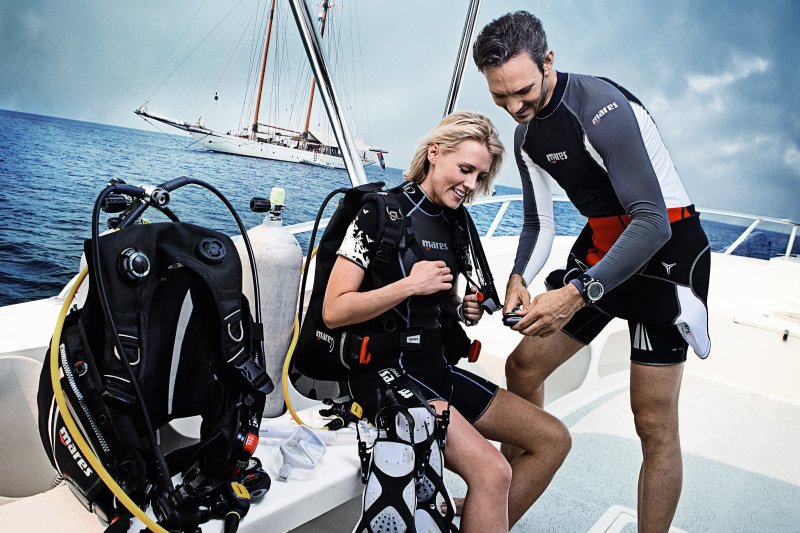Нега опреме за роњење – 6 начина да је припремите за лето
scuba divingenvironmentfreedivingextended rangediving safetyequipment maintenancescuba gear
16 views - 15 viewers (visible to dev)

mares
Лето је у пуном јеку и желимо да се уверимо да је ваша опрема за роњење спремна за сваку подводну авантуру која вам се нађе на путу! Постоји неколико важних ствари које треба да урадите како бисте осигурали да је ваша опрема за роњење у исправном стању. Да ли је већи део године стајала на полици? Погледајте ове једноставне кораке како бисте били сигурни да је ваша опрема у добром стању пре него што је обришете са прашине и одмах се баците на посао.
Пратите овај водич како бисте били сигурни да је ваша опрема за роњење спремна за лето:
1. Регулатор.
Ваш регулатор је један од најважнијих делова ваше опреме за роњење, који вам обезбеђује непрекидно снабдевање ваздухом док истражујете чуда подводног света. Последња ствар коју желите да вам се деси током роњења је да вам регулатор откаже.
Да би се избегао квар регулатора, већина произвођача препоручује годишње подешавање регулатора са потпуним ремонтом сваке друге године.
SSI препоручује да контактирате локални ронилачки центар како бисте се распитали о њиховим пакетима услуга.
Можете оставити целу регулаторску јединицу, укључујући прву фазу, другу фазу и октопод или секундарни извор ваздуха, на преглед.
2. Ронилачки рачунар.
Не желите да започнете спуштање и приметите знак да је батерија на вашем ронилачком рачунару празна.
Дакле, пре него што кренете на следеће роњење, извадите све своје ронилачке рачунаре из складишта, укључите их и проверите ниво напуњености батерије.
Уверите се да сваки ронилачки рачунар исправно функционише са пуном батеријом. Покрените режим планирања роњења на рачунару да бисте се уверили да све ради.
Ако се упали индикатор да је батерија празна, одмах промените батерију ако ваш модел рачунара дозвољава самосталну замену батерије или га пошаљите у најближи сервисни центар.
Обавезно урадите ово пре него што кренете на било какво роњење!
3. Компензатор пловности.
Ваш уређај за компензацију пловности (BCD) не мора нужно да иде на сервисирање у сервисни центар, осим ако не постоји очигледан проблем.
Урадите неколико самопровера како бисте били сигурни да је ваш BCD у добром радном стању:
- Орално надувајте свој BCD да бисте били сигурни да још увек задржава ваздух.
За још темељнију проверу, напуните каду водом или однесите компензатор за плашење до базена и држите га под водом потпуно надуваног.
Ротирајте БЦД под водом и потражите да ли постоје мехурићи који излазе из мехура или заптивача вентила БЦД-а.
- Уверите се да сви испуштајући вентили BCD-а исправно раде.
Испустите ваздух из напуњеног BCD-а повлачењем сваког вентила појединачно.
- Такође проверите џепове за тежине вашег BCD-а.
Уверите се да исправно раде тако што ћете ставити БЦД, додати тежину џеповима и проверити да ли се џепови сами откључавају и отпуштају када се то од вас затражи.
4. Ронилно одело.
Ронила су прилично једноставна и не захтевају много припреме за употребу. Међутим, добра је идеја да испробате своје ронило и проверите да ли вам и даље одговара ако нисте недавно ронили.
Овај мали, али користан корак би вас могао спасити од покушаја да се угурате у премало одело за роњење на љуљајућем чамцу или да вам не буде хладно у превеликом оделу за роњење!
Такође можете проверити да ли је рајсфершлус и даље у добром радном стању и да нема рупа или истрошених делова.
Имајте на уму да је већина модерних ронилачких одела , посебно хипер флекс модели, произведена да траје само око 100 зарона, јер се неопрен трајно мало компресује током сваког зарона.
Старије рониљско одело вас неће грејати колико би требало.
5. Маска, дисалица и пераја.
Већина ронилаца не размишља много о провери своје основне опреме за роњење пре него што се спакују за роњење или је изваде након дуготрајног складиштења.
Ови основни предмети су подједнако подложни хабању као и друга опрема за роњење, посебно ако се чувају у простору са ниским протоком ваздуха и екстремним температурама, попут гараже.
- Проверите силиконску сукњу око маске да бисте били сигурни да није попримила прљаво жуту боју.
Ово би могло указивати на то да се силикон стврднуо и можда није толико савитљив колико би требало, што може довести до сталног цурења маске.
- Проверите да ли су чеп вентила за прочишћавање и усник на вашој ронилачкој дихалици промењене боје.
Врхунски рониоци такође праве ове делове од силикона, а ако нису у добром радном стању, могли бисте завршити са цурећим ронилом.
- Код пераја, проверите да ли су каиш за пету и копче поломљени и да ли је оштрица пераја искривљена.
Пераје треба да изгледа равно, а каиш за пету треба да се лако затеже и отпушта.
6. Ронилачка цилиндар.
Свака боца за роњење захтева годишњи визуелни преглед. Проверите налепницу за визуелни преглед са стране боце за месец и годину када је последњи пут прегледана.
Ако вам је истекао рок трајања, обавезно га однесите у један од ваших локалних SSI ронилачких центара да га визуелно прегледају пре употребе.
Визуелни преглед не траје дуго, али је неопходан за вашу безбедност роњења. Ваш SSI центар ће такође осигурати да је боца у року од 5 година од хидроизолације.
Ваша боца мора бити послата на хидростатичко испитивање сваких пет година. Овај процес траје много дуже од визуелног прегледа, зато проверите своју боцу знатно пре следећег планираног зарона.
Пажљивим проверавањем ваше опреме за роњење пре ваше следеће ронилачке авантуре, спречиће да вам зарони буду упропашћени проблемима са опремом које можете спречити!
Одржавање ваше опреме за роњење у врхунском стању осигураће вам године доброг коришћења ваше инвестиције у опрему и чуваће вас безбедним на том путу.
Погледајте SSI курс о техникама опреме да бисте научили како да извучете максимум из своје инвестиције и уживате у безбедним и удобним роњењима годинама које долазе.